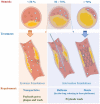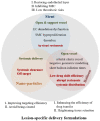Recent advance in treatment of atherosclerosis: Key targets and plaque-positioned delivery strategies
- PMID: 35356091
- PMCID: PMC8958685
- DOI: 10.1177/20417314221088509
Recent advance in treatment of atherosclerosis: Key targets and plaque-positioned delivery strategies
Abstract
Atherosclerosis, a chronic inflammatory disease of vascular wall, is a progressive pathophysiological process with lipids oxidation/depositing initiation and innate/adaptive immune responses. The coordination of multi systems covering oxidative stress, dysfunctional endothelium, diseased lipid uptake, cell apoptosis, thrombotic and pro-inflammatory responding as well as switched SMCs contributes to plaque growth. In this circumstance, inevitably, targeting these processes is considered to be effective for treating atherosclerosis. Arriving, retention and working of payload candidates mediated by targets in lesion direct ultimate therapeutic outcomes. Accumulating a series of scientific studies and clinical practice in the past decades, lesion homing delivery strategies including stent/balloon/nanoparticle-based transportation worked as the potent promotor to ensure a therapeutic effect. The objective of this review is to achieve a very brief summary about the effective therapeutic methods cooperating specifical targets and positioning-delivery strategies in atherosclerosis for better outcomes.
Keywords: Atherosclerosis; balloon; nanoparticle; site-homing delivery; stent; targets.
© The Author(s) 2022.
Conflict of interest statement
Declaration of conflicting interests: The author(s) declared no potential conflicts of interest with respect to the research, authorship, and/or publication of this article.
Figures











Similar articles
-
Macrophages: promising targets for the treatment of atherosclerosis.Curr Vasc Pharmacol. 2009 Apr;7(2):234-43. doi: 10.2174/157016109787455635. Curr Vasc Pharmacol. 2009. PMID: 19356007 Review.
-
Platelet membrane-coated nanoparticle-mediated targeting delivery of Rapamycin blocks atherosclerotic plaque development and stabilizes plaque in apolipoprotein E-deficient (ApoE-/-) mice.Nanomedicine. 2019 Jan;15(1):13-24. doi: 10.1016/j.nano.2018.08.002. Epub 2018 Aug 30. Nanomedicine. 2019. PMID: 30171903
-
Monocyte retention in the pathology of atherosclerosis.Future Cardiol. 2005 May;1(3):331-40. doi: 10.1517/14796678.1.3.331. Future Cardiol. 2005. PMID: 19804116
-
Progression and Characterization of the Accelerated Atherosclerosis in Iliac Artery of New Zealand White Rabbits: Effect of Simvastatin.J Cardiovasc Pharmacol. 2017 May;69(5):314-325. doi: 10.1097/FJC.0000000000000477. J Cardiovasc Pharmacol. 2017. PMID: 28207427
-
Interactions between dyslipidemia and the immune system and their relevance as putative therapeutic targets in atherosclerosis.Pharmacol Ther. 2019 Jan;193:50-62. doi: 10.1016/j.pharmthera.2018.08.012. Epub 2018 Aug 25. Pharmacol Ther. 2019. PMID: 30149100 Review.
Cited by
-
Lipoprotein(a): Assessing the Current Knowledge and Gaps in Screening and Treatment-A Narrative Review.J Cardiovasc Dev Dis. 2025 Apr 26;12(5):169. doi: 10.3390/jcdd12050169. J Cardiovasc Dev Dis. 2025. PMID: 40422940 Free PMC article. Review.
-
Advanced Nanomedicines for Treating Refractory Inflammation-Related Diseases.Nanomicro Lett. 2025 Jul 7;17(1):323. doi: 10.1007/s40820-025-01829-7. Nanomicro Lett. 2025. PMID: 40619552 Free PMC article. Review.
-
Atherosclerosis and Inflammation: Insights from the Theory of General Pathological Processes.Int J Mol Sci. 2023 Apr 26;24(9):7910. doi: 10.3390/ijms24097910. Int J Mol Sci. 2023. PMID: 37175617 Free PMC article. Review.
-
Lecithin and cardiovascular health: a comprehensive review.Egypt Heart J. 2024 Jul 13;76(1):92. doi: 10.1186/s43044-024-00523-0. Egypt Heart J. 2024. PMID: 39001966 Free PMC article. Review.
-
Garlic ameliorates atherosclerosis by regulating ferroptosis pathway: an integrated strategy of network pharmacology, bioinformatic and experimental verification.Front Pharmacol. 2024 Jul 23;15:1388540. doi: 10.3389/fphar.2024.1388540. eCollection 2024. Front Pharmacol. 2024. PMID: 39108744 Free PMC article.
References
-
- Liu Y, Chen BPC, Lu M, et al.. Shear stress activation of SREBP1 in endothelial cells is mediated by integrins. Arterioscler Thromb Vasc Biol 2002; 22: 76–81. - PubMed
-
- Gu L, Okada Y, Clinton SK, et al.. Absence of monocyte chemoattractant protein-1 reduces atherosclerosis in low density lipoprotein receptor–deficient mice. Mol Cell 1998; 2: 275–281. - PubMed
-
- Steinberg D. Low density lipoprotein oxidation and its pathobiological significance. J Biol Chem 1997; 272: 20963–20966. - PubMed
-
- Hossain E, Ota A, Karnan S, et al.. Lipopolysaccharide augments the uptake of oxidized LDL by up-regulating lectin-like oxidized LDL receptor-1 in macrophages. Mol Cell Biochem 2015; 400: 29–40. - PubMed
Publication types
LinkOut - more resources
Full Text Sources
Miscellaneous

